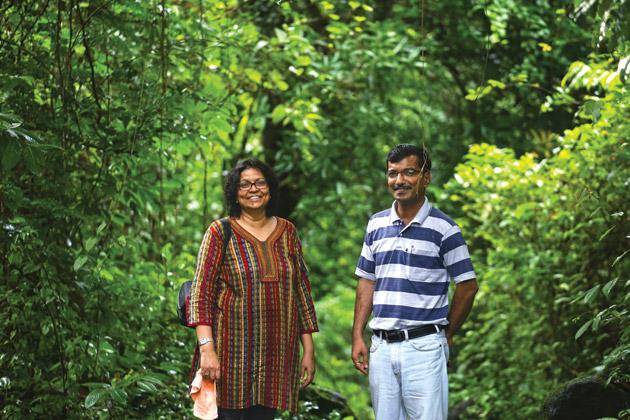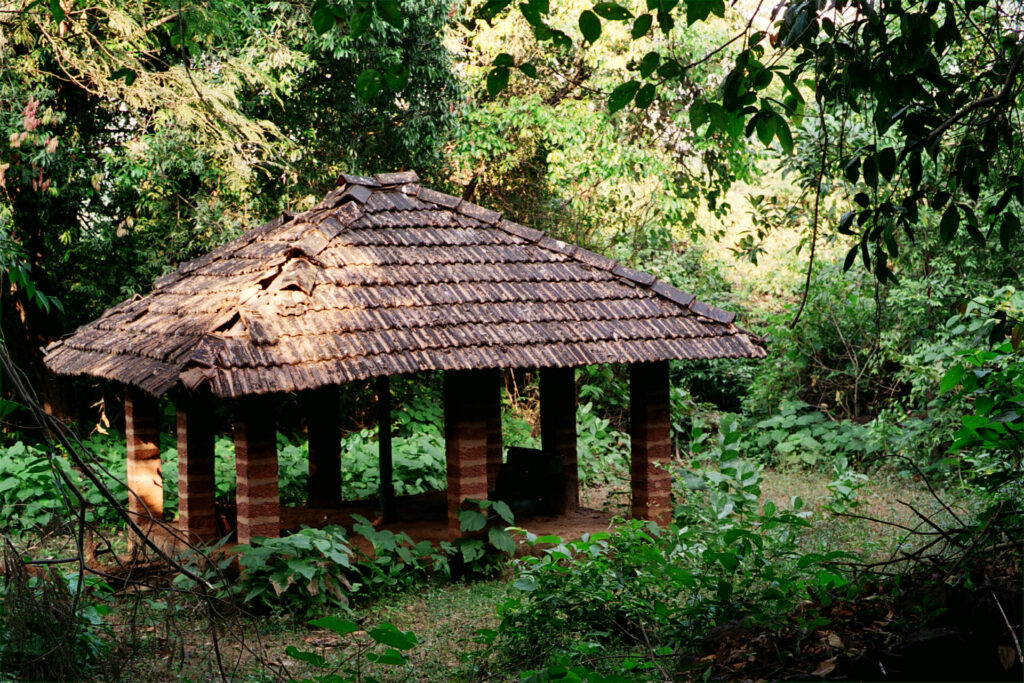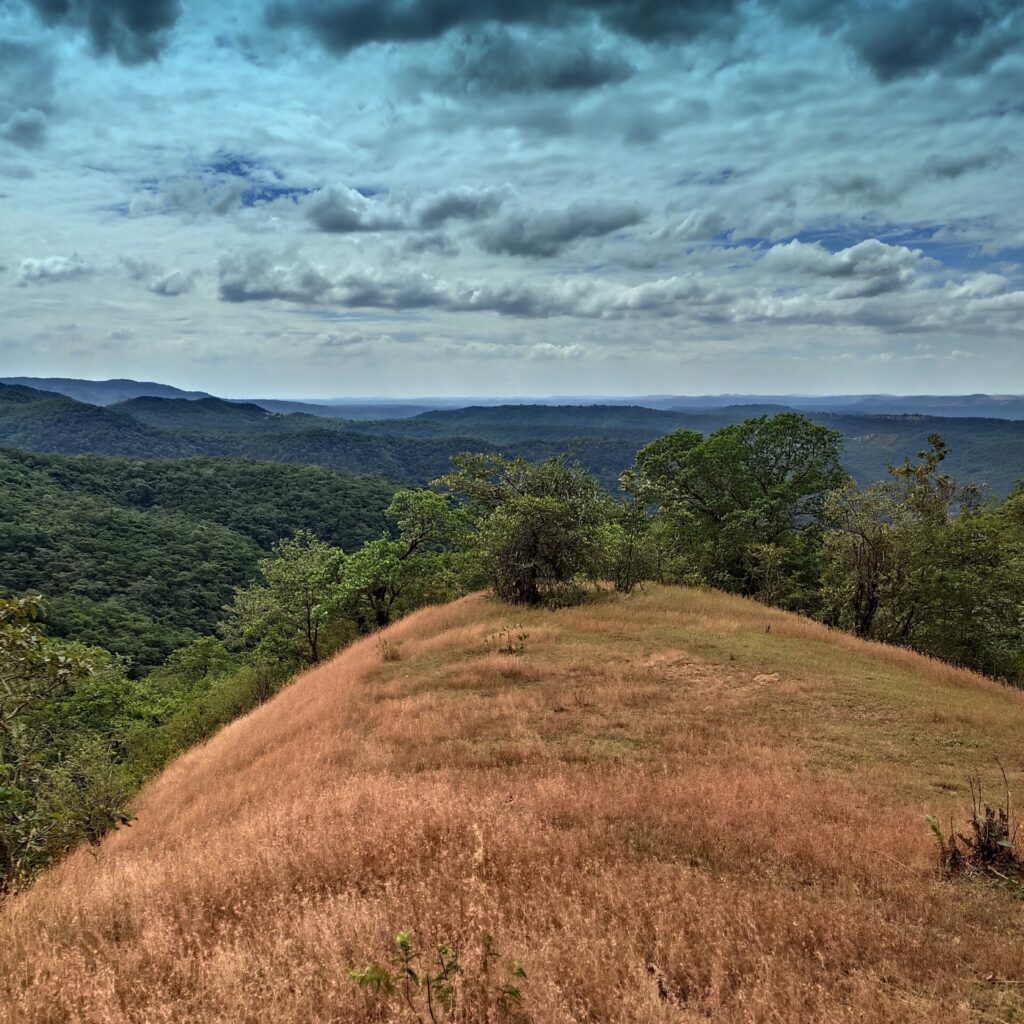
The Great (Pied) Hornbill (Buceros bicornis) is one of the largest of the hornbills, photographed here in a Sacred Grove in the Western Ghats of India. Photo credit: Archana Godbole/AERF.
Flashy birds with their over-sized beaks, the world’s 62 species of hornbill occur across Africa, tropical Asia, Indonesia and Papua New Guinea where they are icons of their forest habitat. They are often referred to as the ‘farmers of the forest’ as they disperse the seeds of many tropical trees, playing an important role in keeping the forest alive. Unfortunately they are threatened by habitat loss and hunting.
World Land Trust (WLT) has been working with Applied Environmental Research Foundation (AERF) for the past two years when a 10 year agreement was signed. Since then, through WLT support, AERF has been able to secure 400 acres (162 hectares) in the Kulye-Phansavle corridor in the mountains of India’s Western Ghats. AERF’s ambition is to protect further private forests and sacred groves through innovative community-based conservation easements to save fragile upland forests from further fragmentation and degradation.

Dr Archana Godbole and Jayant Sarnaik, founded AERF in 1994 to save the biodiversity of the North Western Ghats. It has been their mission to find ways of making conservation financially attractive and meaningful to the people who live alongside the forests. Image credit: AERF.
Dr Archana Godbole explains the importance of hornbills in the forests that AERF is working to protect.
Hornbills are majestic forest birds and are known as forest farmers due to way they disperse the seeds of forest trees across the landscape where they fly. This is the story of how the relationship of these birds, age old practice of maintaining forests in the name of deity has contributed to protection of the sacred groves and the unprotected forests in a vast landscapes in the north Western Ghats, while providing benefits to the community.
Western Ghats is the mountain range running parallel to West Coast of India and the north Western Ghats is part of Western Ghats global Biodiversity hotspot, and unique in many ways. The forest landscapes of North Western Ghats are characterized by three key features which significantly impact their governance: they have a very sparse protected network of only 11 areas; the majority of the forest areas are managed by local communities and there is the presence of a very rich traditional system of forest conservation – the sacred forests (ca. 2000 in numbers).
The landscape harbours biodiversity but lacks legal protection. For the past 25 years AERF has been working with local communities (many of whom are very poor) using innovative mechanisms to mainstream biodiversity conservation in this open access landscape. AERF’s work for conservation on the ground is making difference using innovative approaches like Conservation Agreements and incentive based mechanism, as well as linking green enterprises to communities and conservation.

A traditional temple in a sacred grove. Image credit: AERF/Archana Godbole.
The importance of sacred groves
The north Western Ghats landscape is bestowed with the traditional forest conservation practice of sacred groves that are the old growth forest fragments scattered within the degraded areas. These forest fragments, measuring anything from 1 hectare to 100 hectares, are protected traditionally in the name of a Deity by the local communities, due to a very strong faith system of the past. The sacred forests also play an important role in cultural life of people in this region. Known as devrai or devrahati, (literally meaning abode of the Gods) for every sacred grove, wise ancestors have clearly defined rules and regulations for management, taboos as well as sanction systems for violation of rules. In most of the sacred groves, till a couple of decades ago, the forest surrounding the temple or worship area was equally important as the deities. In some of these forests there was permission to collect certain Non-Timber-Forest-Produce like fallen fruits and leaf litter, but cutting of trees was strictly prohibited. Therefore these groves remained as relic forest patches, even as the surrounding forests exhibited varying degrees of degradation, giving vital clues for understanding the forests of the past.
These sacred groves harbour unique biodiversity, from giant trees once common across the landscape , to elusive creatures like pangolins and civets. They not only protect great species diversity across all taxa (plants, birds, butterflies, insects, mammals, amphibians, reptiles) but also provide critical habitat to important large forest birds such as Great Indian Hornbill and Malabar Pied Hornbill.

A dramatic sight: a Great Hornbill in flight. Image credit: Jambhle/AERF
Big trees and hornbills: a mutually beneficial interdependence
Sacred groves in Ratnagiri district have many giant trees of Terminlia bellirica, Tetrameles nudiflora and Mangifera indica that provide nesting cavities to hornbills. In the surrounding landscape, such giant trees do not survive, so these are the last refuge for hornbills. An age old mutually beneficial interdependence of hornbills and sacred groves plays a crucial role in regeneration of forest tree species in the remaining landscape.
Hornbills are known as forest farmers as they disperse seeds of rare and endemic trees widely across the landscape. The lack of nesting cavities in these large trees is leading to a decline in hornbill populations which in turn can surely spell disaster for biodiversity in this region.
These giant trees also provide raft of ecosystem services such as pollination. Most of the sacred groves have a perennial source of water in the form of tanks and other traditional water harvesting structures – there is no need to emphasize the importance of water. In summary, sacred groves are gene banks and ecosystem service providers of extra-ordinary importance to humanity.
However, globalization and the digital age, the demand for cultivable land, the advent of a market economy coupled with eroding traditional knowledge and belief systems, posed a threat to the future of sacred groves and the biodiversity it supports. Giant trees from the sacred groves are being cut for renovation of temples, to be replaced by exotic species plantations and for ‘beautification’. Other threats such as the building of roads and wider urban development are threatening them too.
The fruits of Terminalia bellirica, known as bibhitaki in ancient Ayurvedic medicine, are a major component of the traditional preparation of trifala, a healing remedy in use for over 1,000 years. Local communities collected these fruits as a supplementary livelihood activity but as interest in ancient medicines has waned, demand for the fruits has too, so communities lost interest in collection. In the quest to make sacred groves beneficial to local people and to engage them in the protection and revival of ancient traditions, since 2011 AERF has been building a community based enterprise around Terminalia bellirica fruits. The development of a certified supply chain was backed by a long term purchase agreement with UK based company –Pukka Herbs. AERF also became the first organisation in South Asia to achieve international FAIRWILD certification for two supply chains in the Western Ghats. Local communities earn at least 60 per cent more income from sustainable collection and get employment opportunities during the lean period. Importantly, their capacity is built in running and managing the enterprise professionally. The yearly audits help them to understand the significance of documentation and transparency. The herbal tea and tablets are sold throughout Europe and Pukka Herbs U.K. is the main buyer of the certified semi processed fruits. With their conscious efforts and support for conservation of hornbills and sacred groves, while sharing benefits with the communities, a sound base has been established and AERF Nature Connect consortium has successfully scaled up the business over the past five years.

Open access landscape from North Western Ghats. Image credit: Akshay/AERF.
The initiative has also helped protect the nesting sites of the Great Pied Hornbill (which has become a flagship of conservation and enterprise model) and the Malabar Pied Hornbill. Thanks to WLT we have been able to save more giant T. bellirica trees, more sacred groves and revive community interest in the value of maintaining the groves. And, of course, the hornbills are there to help regenerate the open access forests in the landscape.”
Thanks to the generosity of WLT supporters making donations to the Action Fund we are able to help AERF save vital habitat in Sacred Forests of the north Western Ghats of India. The Action Fund was set up by WLT as a means of flexible funding for any of our partners’ most urgent conservation projects so they can continue their vital work in conserving habitats, giving threatened species a brighter future.
Many donations to the Action Fund come from WLT Friends who pledge a monthly donation of £5 or more. Become a WLT Friend today to help provide urgent assistance to the conservation projects that need it most or make a one-off donation below.
Become a WLT Friend
Make your commitment to the world’s endangered habitats and their wildlife and become a Friend of World Land Trust today.

